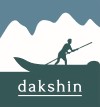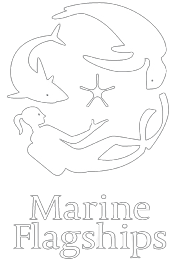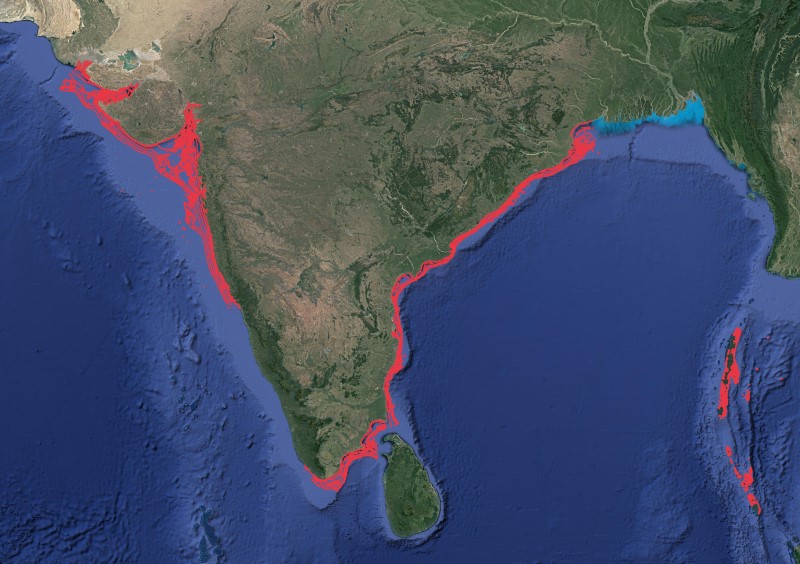Species Name
Spotted Eagle Ray
Scientific Name
Aetobatus ocellatus
Family Name
Aetobatidae
IUCN Status
Near Threatened
The Spotted eagle ray has a dark greenish-grey rhomboidal-shaped disc which is significantly wider than long with white spots on the dorsal surface. It has a moderately long and parabolic rostral lobe. The caudal fin is modified into a whip-like long tail armed with 2-6 venomous spines.
Biology
Length: An adult spotted eagle ray's disc measures approximately 5 to 7 feet (1.5 to 2.1 metres) in width. They can, however, in certain cases grow to a total length of 8.8 metres and up to 10 feet (3 metres).
Gestation period: 12 months
Littter size: Reproduction is viviparous with aplacental histotrophy, bearing upto 4 pups per litter.
Life Expectancy: unknown
Diet: Mostly consumes hard-shelled bottom-dwelling invertebrates, including fish, crustaceans, worms, oysters, clams, and giant mollusks.
Habitat and Distribution
Habitat: The Ocellated Eagle Ray is found in tropical and warm-temperate waters in coastal regions and over the continental shelf. It sometimes enters lagoons and estuaries and is often associated with coral reef ecosystems. It is also encountered well offshore in open water.
Distribution: The exact range of the Ocellated Eagle Ray, which was once thought to be an Indo-West and Central Pacific variant of the more widespread White-spotted Eagle Ray (Aetobatus narinari), has been uncertain due to a previous lack of taxonomic resolve of the "spotted eagle ray" group.
Known landing centres: Royapuram Fishing Harbour, Cuddalore Fishing Harbour, Nagapattinam Fishing Harbour, Junglighat, Burmanallah, Wandoor, and Dignabad, Cochin Fisheries Harbour, Mumbai (Versova, Sassoon Docks, Satpati, Naigaon, New Ferry Wharf), Veraval, Mangrol, Porbander, Okha
Depth: surface to 60 m depth
Commercial value
The individuals landed as bycatch are sold in the local market for consumption. The species are also collected for the marine aquarium trade.
Threats
They face intense fishing pressure and are caught as bycatch using inshore fishing gear (beach seine, gillnet, purse seine, benthic longline, trawl etc). Their small litter size, schooling behaviour, inshore habitat and hence availability to a wide variety of inshore fishing gear, its marketability, and the generally intense and unregulated nature of inshore fisheries across large parts of the species range, pose significant risks to the global population of the ray. Microplastic pollution is also a major factor for the species, leading to complications.
References
- D. Bagade, & Manas Manjrekar, M. Manjrekar. (0000). Preliminary study on elasmobranch species along the coast of Maharashtra. BIOINFOLET, 18, 473-476.
- Mohanraj, Govindaraj & Rajapackiam, S & Mohan, S & Batcha, Hameed & Sukumar, S.Gomathy. (2009). Status of Elasmobranchs Fishery in Chennai, India. Asian Fish Sci. 22. 10.33997/j.afs.2009.22.2.023.
- White, W.T., P.R. Last, G.J.P. Naylor, K. Jensen and J.N. Caira, 2010. Clarification of Aetobatus ocellatus (Kuhl, 1823) as a valid species, and a comparison with Aetobatus narinari (Euphrasen, 1790) (Rajiformes: Myliobatidae). pp. 141-164. In P.R. Last, W.T. White and J.J. Pogonoski (eds). Descriptions of new sharks and rays from Borneo. CSIRO Marine and Atmospheric Research Paper no. 32.



